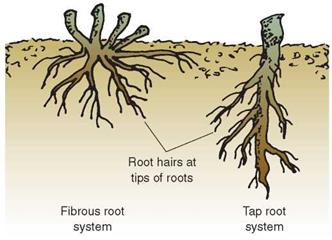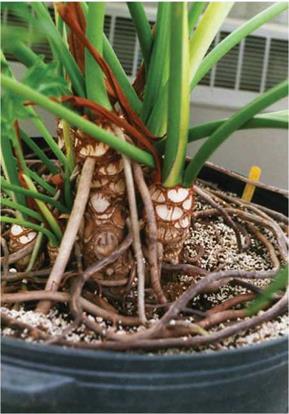The most logical starting point for a scientific study of ornamental plants is their macroscopic anatomy (what we can see with the unaided eye).
Members of the higher plants are made up of roots, stems, leaves, and flowers or cones (Figure 1-1). Flowers are the reproductive structures of the Angiospermopsida as cones are for the Coniferopsida. As previously noted, these two Classes are commonly referred to simply as the flowering plants and the conifers.
Roots
Roots are the below-ground portion of the plant. They may be fibrous, with a network of roots reaching out horizontally and vertically through the soil, or they may be tap roots in which one central root grows larger and is more dominant than the others. In both types of root systems, the larger roots are supplemented by many smaller root hairs (Figure 1-2). The principal function of the roots is to absorb water and mineral nutrients from the soil. Much of the absorption occurs through the root hairs. In addition, the roots serve to anchor the plant against toppling by wind and rain. Roots also store food materials produced in the leaves. Specialized roots called adventitious roots develop from stems in some plants such as philodendron and from leaves and cut stems of various plants being propagated vegetatively (Figure 1-3).
|
|
figure 1-2. Typical root systems of plants (Delmar/ Cengage Learning)
figure 1-і. The principal parts of a flowering plant (Delmar/Cengage Learning)
|
|
figure 1-3. Adventitious roots are seen on this philodendron. They originate on the lower stem. (Courtesy Jack Ingels)
When plants are young, as when they are newly germinated from seeds, the surface area of the roots is greater than the surface area of the leaves, allowing for a greater uptake of mineral nutrients and water than is matched by the photosynthetic activity of the undeveloped leaves. This imbalance is only temporary though, and can eventually tip the opposite way once the leaves expand fully and maximize their food manufacturing capability through photosynthesis. It is generally desirable to maintain a close balance between the ability of a plant to pho – tosynthesize and the root surface area needed to take up the necessary water and minerals.
Roots grow almost continuously throughout the life of a plant. Their rate of growth can be affected by environmental conditions in the soil, such as temperature or moisture extremes. Most root systems will display greater lateral growth than depth. In sites where the soil composition is extremely hard, downward penetration even by tap rooted species may be limited.





